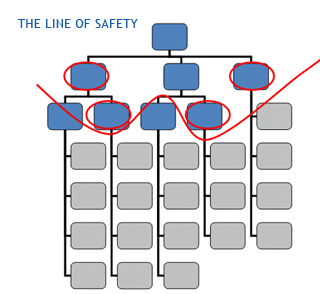Let’s take some time and discuss the power of ideas and their importance as the central component of a True Solutions™. Good ideas facilitate the road to true customer intimacy.
A solution is the embodiment of an idea – and how the idea can be realized. The idea is the kernel of the change in the relationship from pushing products and discussing business opportunities. Often conversations that are supposed to be about solutions are really about how to better use our products and get more bang for the buck in our relationship; these are valuable issues but not True Solutions™ discussions.
As seen in the diagram below, there are many levels of impact from solutions.

The solutions that build intimacy above the line of safety are what we term True Solutions™. These solutions are based upon ideas.

Using ideas as the focal point of discussions with clients immediately changes the dialog and therefore the relationship.
The power of ideas is that they immediately accomplish several things:
- They focus the discussion on the idea – not the sales representatives (or consultants) skills, not the company or current relationship, but the idea.
- They enable a more consultative conversation – discuss the merits of the idea in a particular environment.
- They align with the way real decisions are made – instead of working against the process.
What makes a good idea? Ideas for this discussion are focused upon seizing an opportunity for a company – be it business growth or protection, increase revenue or cut costs. A good idea is not wishful thinking – but a challenge to see the business differently. A good idea should be easy to summarize – to be expressed in a few minutes. A good idea should be actionable, understandable and straight forward to evaluate for applicability. Finally, a good idea should have a “wow” factor.
Granted some ideas are bigger than others – some require a bigger budget, some require more authority to move forward, but all good ideas should draw the client into a discussion about the possibilities.
How do ideas flow with the way decisions are made?
Decisions are made by deciding:
1) Whether to Act,
2) How to Act, and only then,
3) With Whom to Act.
Whether to Act – This stage is all about deciding if something should be done. Is it worth investigating this opportunity or issue(s)? Only when this is decided does How to Act come clearly into view.
How to Act – How can this be done – What are the alternatives? Where are the risks? What’s the game plan? The stage is fruitful with analysis of how to get things done.
With Whom to Act – Can I do this alone, do I need help, who can I trust, etc. This is about selecting partners for the implementation. If you have assisted in Whether to Act and How to Act, then you are the partner for Whom to Act with.
How often have you been involved in a sales situation where all the discussion is about With Whom to Act – our product is better, cheaper, etc.?
For clients to buy from these discussions they must have determined the first two questions without you – either buy themselves or with someone else’s help. Also, long sales cycles are often caused by selling With Whom to Act when the client is still deciding Whether to Act.
The importance of moving up the food chain is paramount – the true value of the relationship is created in the Whether to Act and the How to Act stages of a decision. Also, this help must be paid for – yes paid for, otherwise it is not of any value to client.
